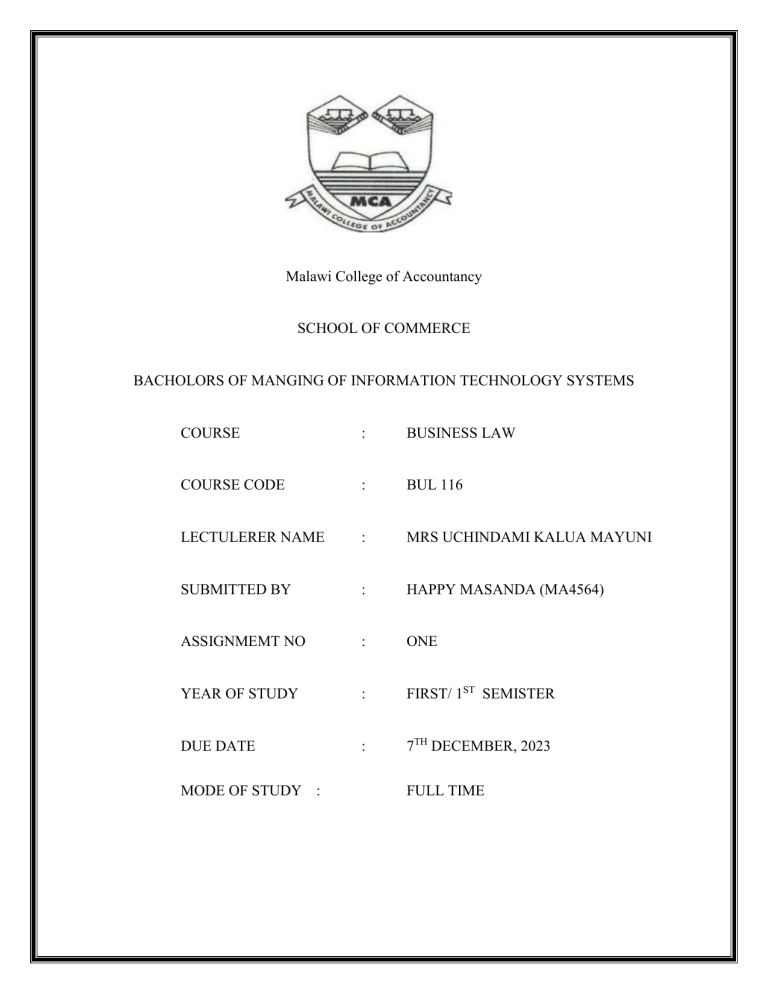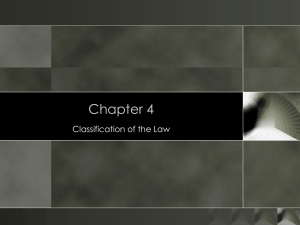
Malawi College of Accountancy SCHOOL OF COMMERCE BACHOLORS OF MANGING OF INFORMATION TECHNOLOGY SYSTEMS COURSE : BUSINESS LAW COURSE CODE : BUL 116 LECTULERER NAME : MRS UCHINDAMI KALUA MAYUNI SUBMITTED BY : HAPPY MASANDA (MA4564) ASSIGNMEMT NO : ONE YEAR OF STUDY : FIRST/ 1ST SEMISTER DUE DATE : 7TH DECEMBER, 2023 MODE OF STUDY : FULL TIME IMPORTANCE OF THE LAW OF TORTS & THE ELEMENTS FOR DETERMINING THE TORT OF NAGLIGENCE A tort is a wrongful act against an individual or body corporate and his, her or its property, which gives rise to a civil action (usually for damages, although other remedies are available) (Kelly, et al., 2002). The law of torts seeks to provide legal remedy for the victims from certain form of harmful conduct (Keenan, et al., 2009). Unlike other remedies the law of torts does not depend on a contractual relationship. The aim of this essay is to explain the importance of the law of torts and the elements that help determine the tort of negligence. Some of the importance of the law of torts include: compensation for harm, deterrence, corrective justice, protection of rights and interests and social policy and regulation. The elements that help determine the negligence tort include: duty of care, bleach of duty, proof of bleach, causation and defense. Firstly, compensation for harm is one of the importance of the law of torts. The law of torts seeks to provide compensation for individuals who have been harmed due to the careless or wrongful actions of others. This law allows individuals to seek compensation for emotional distress, physical injuries, property damage and financial losses. This compensation helps to restore the harmed party to the state it was before the harm occurred. The compensation is most of the time in monetary form. Secondly, deterrence is another importance of the law of torts. The law of torts preventions’ individuals or organizations from doing activities which may cause harm to others. By holding wrongdoers accountable for their actions and imposing financial liability, the fear of potential consequences encourages individuals and entities to act with care and responsibility. This discourages the individuals and entities from doing suck acts because they may be held accountable leaving them at a great loss. Furthermore, corrective justice is also an importance of the law of torts. The law of torts seek to balance the scales between wrongdoers and victims. If aims at changing the imbalance caused by the wrongdoers to compensate the victims. This ensures that those responsible for causing harm bear the burden of changing the harm they have caused. This law makes sure that those who do wrong are punished and face the consequence of their actions. In addition, protection of rights and interests this is another importance of law of torts. The law of torts protects a wide range of rights and interests, including bodily integrity, property rights, reputation, privacy, and economic interests. It provides a legal framework for individuals to seek redress when their rights and interests are violated. By recognizing and protecting these rights, the law of torts promotes a just and fair society. Moreover, social policy and regulation is another importance of the law of torts. Tort law often reflects societal values and public policy considerations. It can influence behavior and shape social norms by establishing standards of conduct and liability. For instance the law of torts has played a significant role in areas such as production safety, environmental production and consumer rights. By imposing liability for harm caused by defective products or environmental pollution, this encourages companies to prioritize safety and responsibility. Furthermore, duty of care is an element of negligence tort. A person is not automatically liable for every negligent act he or she commits (Kelly, et al., 2002). In order to establish duty of care there has to be a sufficient relationship of proximity or neighborhood between the plaintiff and the defendant, in a way that a careless act of the defendant could affect the plaintiff. In order to impose a duty of care the court must question if: the harm caused was reasonably foreseeable, the proximity of the relationship between the plaintiff and the defendant, and in all the circumstances is it fair to impose a duty of care. In addition, bleach of duty of care is another element of the negligence tort. One the claimant has established that the defendant owes him or her a duty of care, he or she must then establish that the defendant is in bleach of this duty (Kelly, et al., 2002). The age of either the defendant or the plaintiff will determine the extent of the duty of care to be exercised. The degree of the duty of care is flexible in accord: the likelihood of injury, the seriousness of the risk, cost and practicability, social unity, etc. Moreover, proof of bleach is also an element of negligence tort. The burden of proof in establishing breach of duty normally rests on the claimant (Kelly, et al., 2002). There cases where legal proofing is burden by the plaintiff requiring him or her to show the negligence of the defendant, but there are some cases where proofing is switched to the defendant. Some cases speak for themselves and these cases do not need detailed evidence to, the court will make an inference from the facts. In addition, causation is another element of negligence tort. The claimant must show that he or she has suffered some injury, but it does not necessarily have to be physical injury (Kelly, et al., 2002) .Causation determines whether the defendants conduct caused the harm for which the plaintiff seeks compensation. There two types of causation called but-for and legal causation. But-for asks whether the harm would have happened without the defendant’s action, and legal causation considers whether the defendants’ actions were a legally significant cause of harm. Lastly, defense is also an element of negligence tort. The extent of the liability of the defendant may be reduced or limited by one of the defenses commonly pleaded in negligence actions (Kelly, et al., 2002). In other words the defenses are arguments that defendants raise to counter a plaintiffs claim of liability. In some cases the plaintiff may have contributed to his or her own injury, in cases like this the amount for the damage will be reduced accordingly. In conclusion this essay has explained the importance of the law of torts and the elements that help determine the tort of negligence. Some of the importance of the law of torts explained include: compensation for harm, deterrence, corrective justice, protection of rights and interests and social policy and regulation. The elements that help determine the negligence tort explained include: duty of care, bleach of duty, proof of bleach, causation and defense. References Keenan, D., Riches, S. & Allen, V., 2009. Keenan and Riches Business Law. 9th ed. Edinburg: Pearson Education Limited. Kelly, D., Holmes, A. & Hayward, R., 2002. Business Law. 4th ed. London: Cavendash Publishing Limited.




